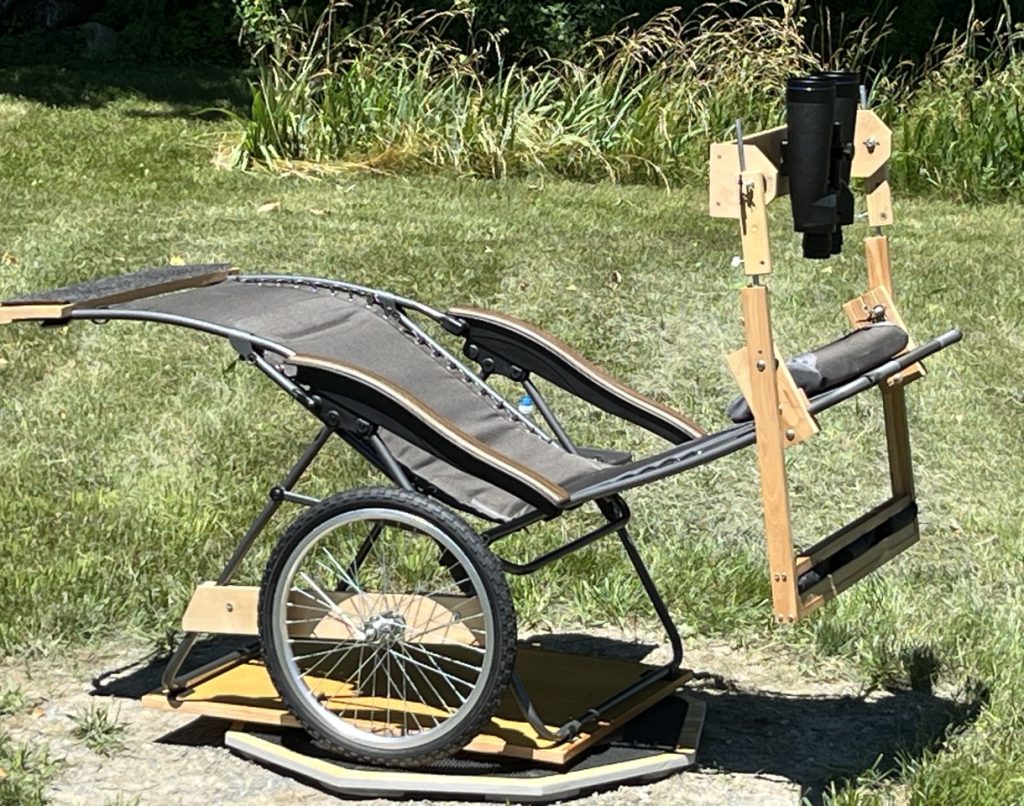A zero gravity chair works best to meet all of the requirements for a comfortable fully functional binocular chair. From our experience, it has been determined that most other chair styles will have one kind of limitation or another.
There must be fully open steel tubing at the tops of the sides of the chair’s backrest, that has no attached fabric (see pic). This is where a bino-holder mount can be clamped and can slide up and down to match the heights of various users. The head cushion should also not be attached to the backrest frame, but instead to the backrest fabric. During use, another cushion can be slid under the chair’s cushion. This will support the nape of your neck, for high elevation viewing. A standard width chair is recommended (see “Specifications” section below).

Non-zero-gravity chairs: Some may wish to rotate their chair by pushing with their feet on the ground instead of using a hand driven wheel. In this case, any standard tube frame chair can be used, as long as your feet stay on the ground comfortably. Again, there should be fully open steel tubing, with no attached fabric, at the tops of the sides of the chair’s backrest. There will be a limitation to the comfortable viewing elevation when using these chairs. This would be a good choice if the intention is for daytime nature viewing only, since not much elevation is normally needed for this. You could leave the chair set up on your porch or by your window.
For any bino-chair which reclines substantially, counterbalancing should be used at the front of the chair. This will help prevent the bino-chair from tipping over backwards, and will assist when returning to an upright position.
One can avoid building the entire rotating azimuth control component by using a swiveling “orbit-beach-chair”. However there would be significant instability and viewing elevation limitation. Tipping over backwards is even possible without weight leverage at the front of the chair.
Conclusion: It’s generally much better to use a standard zero gravity chair. They tilt back very far, as your legs rise comfortably. If you want to view all the way up to zenith, you then just arch your neck a little. The nape of your neck can be supported by a large added cushion. The front of the chair extends well out, and is a great location for a counterweight board because of the leverage. The top surface of this counterweight board also acts a comfortable leg rest.

Specifications: The “W” width in a zero gravity chair spec often refers to the distance between the outer edges of the armrests. A standard 30″W or 31″W chair typically has seat fabric which is about 24″ wide (some retailers may call this a 24″W chair, so it can be confusing). Standard sized zero gravity chairs are often called XL, XXL or Oversized, no doubt to increase sales. A standard chair has a base frame about 27″ wide, side-to-side. The frame at the base is about 30″ from front to back. An extended length of at least 72″ is typical and is recommended. It should have close to a 170° recline. For sturdiness, the chair should be rated for ~350 lbs. and the net weight should be at least 20 to 22 lbs. A higher weight rating should translate to more stability, regardless of your body weight. Often included is a tray table, and small levers under the armrests to lock the tilt of the backrest.
Zero gravity chair models to consider: Online comparison is suggested, which is especially true when in-store choices are limited during off-season.
- Portal: 350 lbs rating, 30″W width between outer edges of armrests, open tops of sides of backrest frame (fully tested)
- Timber Ridge: 350 lbs rating, 31″W width between outer edges of armrests, open tops of sides of backrest frame, Amazon: B08F57JS96 (untested but should meet requirements)
- Timber Ridge: larger model, 500 lbs rating, 33″W width between outer edges of armrests, open tops of sides of backrest frame, Amazon B08FJ998C3 (untested but should meet requirements)
- Cabela’s Big Outdoorsman Lounger: 400 lbs rating, ~31″W width between outer edges of armrests, open tops of sides of backrest frame (untested but should meet requirements)
These types of zero gravity chairs may result in some bino-chair limitation:
- chairs under 20 lbs with a weight capacity rating under 350 lbs
- chairs without open steel tubing near the tops of the sides of the backrest
- chairs that are much wider than 33″
- chairs that don’t recline back close to 170°
- chairs under 6 feet long when extended
- summer chairs with open mesh backrest fabric are less insulated and less padded
Special request: if you come across other suitable zero gravity chairs, especially chairs that have over 72″ extended length, please add a comment below.

Leave a Reply